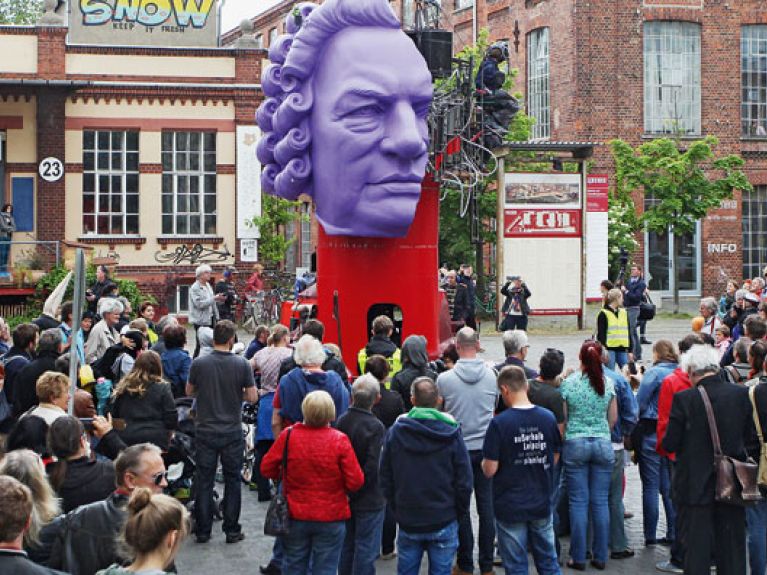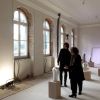Creative imperfection
Art in a bunker, greenhouse or cellar: off spaces enable a relaxed approach to art. Sometimes they even become an art brand.

The night was already well advanced when the Elbe Philharmonic Hall appeared down at the end of the Reeperbahn in Hamburg. Here the “scandalous” new concert hall meets the city’s other spectacular buildings for a wrestling match – against Godzilla’s gang of monsters. Amidst the howls of the spectators, some of whom come from the local artists’ scene, while others have been drawn by the action on their way to Hamburg’s famous entertainment district, the cardboard architecture loses the cultural fight against the plastic mutants and goes up in flames, a blazing auto-da-fé. The performance of the art-sport-project entitled Rock & Wrestling was the resounding finale of a small off-festival that for one whole night dealt with the trend towards spectacle. “08/15 – a City Seeks to Connect” was organised by the three curators Filomeno Fusco, Björn Salzer and Hartmut Gerbsch and offered a delightful event-travesty with numerous guests from Hamburg’s subculture. At the same time it alluded to an altogether serious state of affairs: like the funds for the promotion of urban culture, public attention focuses much more on big events geared towards the media than on vibrant local artists’ scenes.
Yet the many self-organised project spaces in almost all Germany’s large cities are among the most dedicated and original exhibition venues in existence – and they have the lowest inhibition threshold. While many people find a visit to a museum or gallery a little daunting, the small neighbourhood art space is more inviting. And off-spaces are often located in places where they reach chance passers-by. Size is of no particular consequence here, as most of these project spaces exhibit artists who are probably unknown and want to test the initial response to their work on a small scale. Spaces, a recently published guide to free art locations in Germany, lists 250 examples in 41 cities including former kiosks, petrol stations or butcher’s shops, tiny huts, cellars and greenhouses, porter’s lodges and alcoves in house walls. These venues are used by small art societies and students’ or artists’ groups. This unorthodox kind of art communication can only be financed by membership dues, donations and patrons or small project subsidies from local authorities.
If that does not work, then these micro art galleries are closed again and new ones are opened in other niches. These projects can rarely become established, because at some point the organisers have to earn money. Only now and then does such a playground turn into a commercial gallery. And in very rare cases small beginnings give rise to large internationally known projects like the Cotton Spinning Mill in Leipzig. That huge studio and gallery complex used to be an off-space and then became an art brand thanks to the fame of a number of painters from the New Leipzig School, like Neo Rauch or Tim Eitel, who found studio space in the old factory. As a rule, the fluctuation in these free nests for artistic fledglings is so great that when curious visitors follow up recommendations in art magazines they find many artists are no longer at the published address. However, the creative flexibility inherent in this exhibition concept has resulted in these self-organised exhibition venues becoming a well-respected field for new art, above all in Berlin, Hamburg, Cologne, Dusseldorf and Munich.
That is why the Project Space Festival in Berlin has organised a four-week “trip through the city’s independent art scene” every summer since 2014. The programme brings participants into contact with groups doing nude drawing in the street or student boxing matches in a lecture theatre. Indeed, even the large events have long since begun to open up special spaces for experimental art. It has become part of the etiquette of large cultural festivals to move into an empty regional airport, a bunker or a dilapidated sanatorium with performances or installations. No location is so remote that it cannot ignite this fever for a quirky atmosphere in which art acquires a totally different impact from what it would have in the White Cube.
Many of the up-and-coming artists who initially exhibit in alternative project spaces are also familiar with another form of novel art sojourn: numerous German artist-in-residence programmes grant artists access to palaces, water mills, industrial plants or old towers for a period of weeks or months so as to enable artists to work in peace. Since 2016 even the Federal Foreign Office (AA) in Berlin has made a space available under its roof for its FFO AArtist in Residence Programme. The first artist to prepare for an exhibition there was the photographer Andréas Lang, and his show was about German colonialism. After him, the performance artist Kerstin Honeit and the draughtsman Ahmed Kamel will use the attic as a laboratory of ideas. Germany’s most famous and attractive artist-in-residence programme, the one-year sojourn, with studio, in the Villa Massimo in Rome, is also a project of the Federal Government.
Despite this variety of special art locations, anyone interested should have realistic expectations if considering that path. Often exhibitions owe their genesis to personal friendships more than critical assessment. Not every off-space artist can be expected to be part of the next documenta. Yet the aspiration of these grassroots galleries is seldom to be a booster for artists’ careers. What makes this whole scene such an important factor in the liveliness of the respective cities is a relaxed approach to art that cordially invites people to participate without any of the perceived arrogance of the art market. Sometimes global careers are born in imperfect conditions, as in the case of Kippenberger’s Office, which the artist Martin Kippenberger ran in Berlin during the late 1970s in order to exhibit his own works and those of his friends. Then these small grungy exhibition venues with their provisionally hung artworks gain legendary status. ▪

